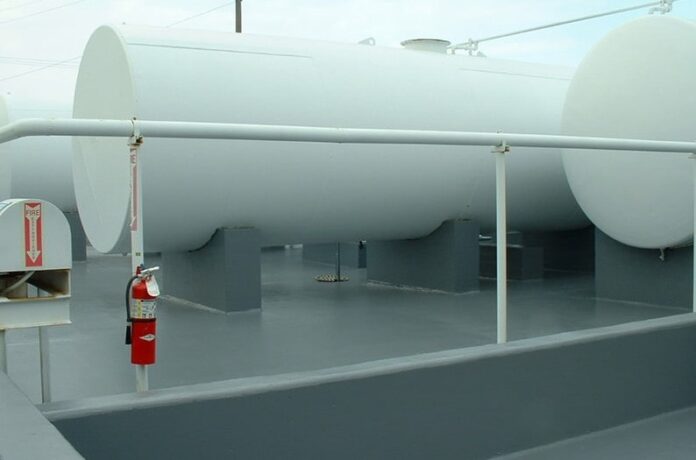Propane polyurea containment systems are becoming more and more common in industrial environments because of their great efficiency, durability, and protective capabilities. These systems are used to build impenetrable barriers that stop propane and other dangerous compounds from leaking, seeping, or contaminating nearby areas. Effective containment solutions are crucial given the possible risks associated with handling propane. This page will explain propane polyurea containment, its uses, advantages, and reasons it’s the best option for environmental and safety preservation.
Table of Contents
What is Propane Polyurea Containment?
A protective barrier system created with polyurea coatings intended especially to contain propane gas or liquid is referred to as propane polyurea containment. One kind of elastomeric coating that generates a seamless, flexible, and extremely durable layer when applied is polyurea. Whether propane is in liquid or gas form, this layer offers an impenetrable barrier that can successfully stop it from escaping and shield the surrounding area from any leaks or spills. These containment systems are frequently found in establishments that handle, transport, or store propane, including refineries, chemical factories, fuel storage facilities, and propane distribution centers.
The Science Behind Polyurea Coatings
Polyurea is a polymer that arises from the reaction of an isocyanate chemical with a mixture of resins. This chemical reaction produces a very adaptable and quick-curing covering with special qualities like:
- Increased tensile strength
- Outstanding adaptability
- Abrasion- and chemical-resistant
- Capabilities to provide waterproofing
- Resilience to weather and UV
- Polyurea is a great material for containment applications because of its quick drying time and versatility, particularly in environments where propane containment is crucial.
Benefits of Propane Polyurea Containment
When compared to more conventional containment techniques like epoxy coatings, steel, or concrete, polyurea coatings for propane containment offer a number of benefits. The following are some main advantages:
Seamless and Flexible Barrier
- The smooth application of polyurea confinement is one of its biggest benefits. In contrast to other materials, polyurea creates a seamless, one-piece barrier without the need for joints or seams. This gets rid of any possible weak spots where leaks could happen.
- Because of its flexibility, it can grow and shrink together with the supporting structure, lowering the possibility of cracks or fractures over time. This flexibility is especially crucial in settings where there are temperature swings.
Rapid Curing Time
Polyurea coatings may be applied quickly with little downtime because they cure in a matter of seconds to minutes. This lowers the cost of disruptions and is especially useful in industrial situations where operations must resume as quickly as feasible.
Chemical and Abrasion Resistance
Because propane polyurea containment systems have a high degree of chemical resistance, they are appropriate for settings where people frequently come into contact with propane or other chemicals. Even in challenging circumstances, this resistance guarantees the containment system’s durability and integrity.
In addition, the coating resists impact, abrasion, and physical wear, offering durable protection against harm.
Waterproofing and Corrosion Protection
Excellent waterproofing properties are offered by polyurea, which keeps moisture out of the air before it may lead to rust or corrosion, particularly on metal surfaces. This feature is essential for preventing environmental harm to propane storage tanks and infrastructure.
Customizable Application
Numerous surfaces, such as concrete, steel, wood, and geotextiles, can be treated with polyurea. Because of its adaptability, it can be used in a variety of propane containment structures, including storage tanks, pipelines, and secondary containment zones.
Environmentally Friendly
Polyurea coatings are considered environmentally beneficial due to their lack of volatile organic compounds (VOCs) and hazardous air pollutants (HAPs). They provide a secure containment option that reduces the possibility of propane spills and contaminated environmental effects.
Applications of Propane Polyurea Containment
Systems for containing propane polyurea have several uses, which makes them essential in sectors where handling and storing propane is commonplace. The following are a few of the main applications:
Systems of Secondary Containment
- In the event of a leak or accident, secondary containment measures are crucial for stopping the spread of propane. Concrete, steel, or earthen containment facilities can be coated with polyurea to form an impermeable barrier that will catch any propane that escapes.
- In propane storage facilities, distribution centers, and refineries, where leaks could pose a threat to public safety and the environment, this use is essential.
Secondary Containment Systems
- Propane storage tanks are frequently lined internally with polyurea to prevent abrasion, corrosion, and chemical damage. By using this application, the possibility of propane leaks is reduced and the tank’s integrity is guaranteed.
- The polyurea coating’s seamless construction also keeps moisture out of the tank, which would otherwise lead to rust and damage.
Tank Coatings and Linings
Propane pipes are shielded from corrosion, impact damage, and environmental exposure by polyurea coatings. The coating creates a strong barrier that increases the pipeline’s longevity and lowers the risk of leaks.
Pipeline Protection
To limit any possible spills, dikes and propane containment pads are frequently built around propane storage tanks. These buildings have an additional layer of defense provided by polyurea coatings, which guarantee that propane that escapes is contained inside the approved region.
Containment Pads and Dikes
For optimal application and efficacy, installing a propane polyurea containment system necessitates a professional approach. An outline of the installation procedure is provided below:
The Installation Process
To guarantee the best possible adherence, the surface to be coated needs to be properly cleaned and prepped. To get rid of any dirt, rust, oil, or pollutants, this may entail sandblasting, power washing, or chemical cleaning.
Surface Preparation:
High-pressure spray systems are commonly used to apply polyurea coatings because they provide equal distribution and quick drying. For optimal protection, the coating is applied in several layers, increasing in thickness as needed.
Application:
Even though polyurea cures in a matter of seconds, it is imperative to give the coating enough time to solidify completely before using it extensively. After that, the containment system is examined to make sure the coating is flawless, correctly applied, and error-free.
Maintenance and Longevity
Propane polyurea containment systems are notable for their low maintenance requirements. These systems require little maintenance after installation and provide enduring protection. To guarantee the integrity of the coating, periodic examinations are advised, particularly in high-traffic or high-impact areas. In the event that wear or damage is found, repairs can be completed effectively and promptly.
Conclusion
Propane leaks, spills, and contamination can be avoided with the use of propane polyurea containment, an innovative, dependable, and effective method. It is the best option for companies where handling propane is a routine aspect of operations due to its easy application, robustness, resistance to chemicals, and quick curing time. Propane polyurea containment systems provide a strong barrier that guarantees protection, compliance, and peace of mind as safety and environmental considerations remain paramount.
Industries may preserve the integrity of their propane handling and storage infrastructure, as well as their operations and the environment, by making an investment in a propane polyurea containment system. It’s a creative, astute solution that preserves the highest safety standards while satisfying the requirements of contemporary industrial processes.



